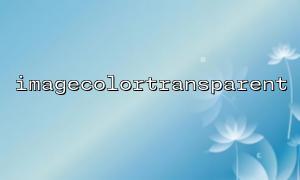In PHP's GD library, the imagecolortransparent function is used to set a transparent color for an image. Its main purpose is to designate a color in the image as transparent, causing all pixels of that color to appear transparent. However, many developers find that when they try to precisely set transparent areas, particularly in complex color or gradient regions, simply using imagecolortransparent doesn't achieve the expected result. This article will provide a detailed explanation of how to use imagecolortransparent to accurately set transparent areas, along with some useful tips and examples.
<?php
// Create a 100x100 true color image
$image = imagecreatetruecolor(100, 100);
<p>// Fill the image with a red background<br>
$red = imagecolorallocate($image, 255, 0, 0);<br>
imagefill($image, 0, 0, $red);</p>
<p>// Set red as the transparent color<br>
imagecolortransparent($image, $red);</p>
<p>// Output the image<br>
header('Content-Type: image/png');<br>
imagepng($image);<br>
imagedestroy($image);<br>
?><br>
In the above code, imagecolortransparent specifies the red color $red as the transparent color, so the red part of the output PNG image will appear transparent.
imagecolortransparent can only set one color as transparent, and this color is obtained using the imagecolorallocate or imagecolorat function to get the color index. The problem is:
It can only make one color transparent and cannot handle gradients or multi-color transparency.
If the image is in true color mode (created using imagecreatetruecolor), the transparent color will automatically convert to palette mode, which may cause color distortion.
Color matching must be exact; even a small color deviation will cause the transparency to fail.
Convert the true color image to a palette-based image (imagetruecolortopalette), then set the transparent color.
<?php
$image = imagecreatetruecolor(100, 100);
<p>// Draw a green rectangle<br>
$green = imagecolorallocate($image, 0, 255, 0);<br>
imagefill($image, 0, 0, $green);</p>
<p>// Convert to a palette-based image with a maximum of 256 colors<br>
imagetruecolortopalette($image, false, 256);</p>
<p>// Find the color index of the transparent color<br>
$transparentIndex = imagecolorclosest($image, 0, 255, 0);</p>
<p>// Set the transparent color<br>
imagecolortransparent($image, $transparentIndex);</p>
<p>header('Content-Type: image/png');<br>
imagepng($image);<br>
imagedestroy($image);<br>
?><br>
Note that this method is suitable for images with fewer and fixed colors. After converting to palette mode, some color details may be lost.
For true color images, it's recommended to use PNG images with an alpha channel and the imagesavealpha function to set transparency at the pixel level.
<?php
$image = imagecreatetruecolor(100, 100);
<p>// Enable saving alpha channel<br>
imagesavealpha($image, true);</p>
<p>// Draw a semi-transparent blue background<br>
$transBlue = imagecolorallocatealpha($image, 0, 0, 255, 80);<br>
imagefill($image, 0, 0, $transBlue);</p>
<p>// Draw an opaque white circle<br>
$white = imagecolorallocatealpha($image, 255, 255, 255, 0);<br>
imagefilledellipse($image, 50, 50, 80, 80, $white);</p>
<p>header('Content-Type: image/png');<br>
imagepng($image);<br>
imagedestroy($image);<br>
?><br>
This method is more flexible, supporting gradients and semi-transparent effects, making it suitable for complex transparency requirements.
Assume you have an image and want to make a range of colors transparent. You can combine pixel iteration with color checking:
<?php
$image = imagecreatefrompng('http://m66.net/sample.png');
<p>// Get the width and height of the image<br>
$width = imagesx($image);<br>
$height = imagesy($image);</p>
<p>// Define the color range to be made transparent (e.g., near white)<br>
$threshold = 30;</p>
<p>for ($x = 0; $x < $width; $x++) {<br>
for ($y = 0; $y < $height; $y++) {<br>
$rgb = imagecolorat($image, $x, $y);<br>
$r = ($rgb >> 16) & 0xFF;<br>
$g = ($rgb >> 8) & 0xFF;<br>
$b = $rgb & 0xFF;</p>
if ($r > 255 - $threshold && $g > 255 - $threshold && $b > 255 - $threshold) {
// Set the pixel as fully transparent
imagesetpixel($image, $x, $y, imagecolorallocatealpha($image, 0, 0, 0, 127));
}
}
}
// Keep alpha channel information
imagesavealpha($image, true);
header('Content-Type: image/png');
imagepng($image);
imagedestroy($image);
?>
By iterating through the pixels, you can control the transparent areas more accurately, making it suitable for complex image transparency processing.
imagecolortransparent is suitable for setting a single color as transparent but has limited applicability.
True color images can use palette mode in combination with imagecolortransparent, but this results in color loss.
It is recommended to use PNG images with an alpha channel, and use imagesavealpha and imagecolorallocatealpha to achieve fine-grained transparency.
Complex transparency requirements can be achieved through pixel iteration and color checking for precise control.
By mastering these techniques, you can flexibly use PHP's GD library to accurately set transparent areas in images, meeting various development needs.


